Sponsored By
ROCK
HARDWARE
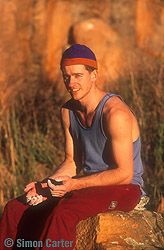
[ More Interviews
Date: 12/08/2003
Intro: Local climber, Dr. Julian Saunders, BMSc BSc MHSc, with degrees in
Sports Physiology and Osteopathy runs
Athlon Sports Medicine in Melbourne. He has several impressive first
ascents to his credit, having put up the Grampians routes Lifestyling (31)
on Spurt Wall and Breathing Gasoline (31) at Millennium Caves in 2000, and
Bossanova (31), just left of Chicane on Afterglow Wall in December 2001.
He's also a keen boulderer, repeating numerous hard problems and creating
lines such as a V10 at Rumbler Wall in the Grampians. He has been unable
to avoid a certain degree of fame after his picture appeared on the front
cover of Simon Carter's popular "Rock Climbing In Australia" photography
book. Photos of his bold ascents continue to pop up in climbing calendars,
magazines and instructional books. Chockstone found Julian at that classic
haunt of Arapiles climbers, the Natimuk pub, working the pool tables with
a large group of friends, kicking back after a long days play on the
rocks. A brief conversation later, and this interview was arranged.
Q: Once upon a time you were new to climbing. How'd you get started? Did you have a mentor? Can you recall your first experiences on rock?
Like most people who started climbing more than 10 years ago, I discovered it at university, in my case La Trobe Uni mountaineering club. I had just broken up with my girlfriend at the time and was currently not cycling on account of an elbow injury (ironically). As happens after a break-up, esp. when you are 21, you go looking for a new adventure. I was working at the uni sports centre so was always seeing these geeky looking guys with HUGE ripped torsos, and lycra-to-die-for, scaling a few glue-up routes on the side of the centre. So I put my name down for a beginnerís trip and off to the gramps I went. Entering summer day valley was like entering a new relationship; no time for anything else. Sold my bike a month later, finished uni that year, and proceeded to defer the next couple to climb.
My first climb was like getting into a boxing ring; I was a bit scared, no idea what to do, but thrashed away none the less. Got quite bruised and beaten. Iíd like to say I exited the ring victorious, but I am still there!
Q: I notice you've put up
the first ascent of routes such as Lifestyling (31) on Spurt Wall,
Bossanova (31) on Afterglow Wall and Breathing Gasoline (31) at Millennium
Caves, all the Grampians. I'm guessing these are steep, powerful routes.
Would you say overhangs are your strength? What attracted you to these
lines and can you tell us a bit about them?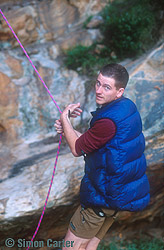
When I was predominantly climbing (rope), it was the seeming impossibility of climbing something overhanging that made me want to do it. The first two routes you mention are not that steep, maybe only overhanging 4-5 meters. Breathing Gasoline is a very different story. I have not been up there for a long time but I guess it overhangs more than 15 meters. Steepness certainly catches my eye, but uno, usually it is the aesthetics that lure me in. Bolting a route is arduous work. It takes a special line for me to go and get my drill out. If I can turn a blind eye to it I usually will.
When I think about these routes it is not the brain numbing description of moves that comes to mind; you canít appreciate a jig saw puzzle by having someone explain how to fit 2 pieces together, or what they look like as single pieces. It is the process of putting it together that is the fun bit. I could tell you the logistics of each route, but personally I find that as boring as bat shit!
They are all great routes, though I am biased of course. Lifestyling and Shattering Reflections are particularly special for me. Mainly for the people around at the time.
Q: Can you give us a quick tick list of some of your hardest ascents of routes and boulder problems? Have you ever taken a stab at the Arapiles test piece Punks In The Gym (31)?
No. I would need to climb at
Arapiles for that. To do that I would need to drive past the Grampians
more than once in a blue moon. As for a tick list, ummm, naa. I will tell
you the best routes and boulder problems I have done though. Letís see...
all of mine of course, theyíre for sure really hot. Bouldering, there are
just too many but Riding Shotgun at Andersons and Orca and Towering
Inferno at Lego Land are a few cool ones. Routes- Slopin Sleezin is one
of the best ever, even though it is at araps. Actually I recently scared
myself silly on auto defe that was supreme retrospective fun. Shattering
reflections and lifestyling are favorites of my own routes. Tunnel to
Caracas at millennium Caves. Must go and do Serpentine as it is meant to
be really cool. The last pitch of word party is outrageous. Bladderhosen
in the blue mountains. MmmÖ2 mike law routes so far! The list is endless.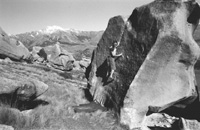
Below Right:
Julian bouldering somewhere overseas. Photo by Ross??
Q: Is climbing high grades something you train for and pursue year round, or does your interest fluctuate? Are you involved in other sports, for example? Do you still cruise up easy routes just for the fun of it?
Pretty much all year round, though I try and take two 6 week breaks each year so I donít fall apart (a hangover from exam periods which seems to work). Last year I didnít, and I fell apart. The weekend I bumped into you I was at araps doing easy things with a good friend; heaps of fun, and easy routes will always teach you something, if not least of all to give them the respect they deserve. Motivation does fluctuate at times though it is normally an index of whether I have projects on the go, i.e. my motivation is mostly for new things. I donít so much Ďtrainí as just go climbing. You will get better by default. I go to the gym maybe once a month, twice if I am unlucky.
I have tried surfing but am
useless at everything when I get cold. Do a little snowboarding, cool fun,
though I am still scarred by the memory of my bruised butt after the first
time I went. My girlfriend is hot on a snow board, and sheís really good
at it. . I do enjoy it, but really I go just to be seen with her.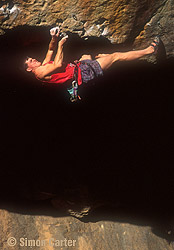
Q: Can you give us an idea of how your climbing life transpires? Do you typically go on extended climbing trips for weeks at a time, or are you predominantly a weekend cragger? Do you target routes ahead of time and work on them feverishly until success, or do you kind of just rock up and go with the flow of your friends?
Most weekends I go to the gramps except over summer, which is too hot for me. I usually go OS around this time of year for 2-3 months.
I used to be the most fixated person I know. I was terrible. I climbed a lot with Simon Atkins, and I strive to climb like he does, if you canít do it fast then come back when you can. It is much more enjoyable. I am a lot better at it now but 6-8 years ago I was useless. I would keep trying until I broke something; that being me! I am now not injured nearly as much (discounting the last 12 months), nor am I driven to tears quite so often by failure. I put up a route in Nowra, Narcosis, which took so f....g long it was ridiculous (it was way out of my league when I bolted it. Some would call it audacious, I would call it deluded). Paul Westwood dubbed it Trail of Tears!
Q: Do you have a nemesis? A project that you've been working for sometime that yet eludes you?
Happy camper on the campsite
boulder. I canít do it. I have tried and tried (with out been fixated!).
Oh yer there is a 21 at Nowra on the left side of Betty blue wall, canít
remember its name. Must have tried it 20 times. If I had done it I would
have graded it 30.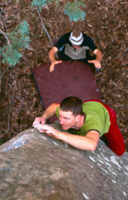
Q: A lot of people will probably recognize you from the front cover of Simon Carter's very popular "Rock Climbing In Australia" photography book. I've also seen your picture in guides, calendars, magazines and instructional books. Combined with your accomplishments as a climber, this fame must effect the way people interact with you, perhaps making them hesitant to approach and talk to you? Has notoriety and recognition been a positive or negative thing?
Both. Every tall poppy in the country wants to line you up; there are quite a few. People certainly tend to judge you on first impressions. One guy from Sydney didnít like me for a whole year and I didnít even talk to him (maybe that was the problem). He told me this a year later when I went climbing with him and he thoughtfully reviewed his opinion. Based on that I have avoided it for the last few years. People look at you as though your opinion is more important than somebody elseís, which is of course crap. Or they wonít say hello because they feel intimidated or think that you wonít want to talk to them because they donít climb as hard. All really really silly. I didnít like that people were thinking about me, or thought something about me when I did not know them.
From a finance perspective it has
been great. Climbing paid my way through school. It enabled me to travel
every year around the world on some climbing adventure with my friends.
And now my business is 70% climbers; which is cool as they are mostly
motivated patients (to get better) and typically well educated,
interesting people. Most of them came to see me because they new my name
as a climber and wanted their injury considered with climbing in mind. So
I canít complain, but it is definitely a double edged sword.
Q: In Simonís book there are shots of you plummeting off "Shattering Reflections of Narcissism" (29) at Millennium Caves. The terrain looks unbelievably steep. Is falling something you've come to terms with or does it still scare the living daylights of out you, like it does the rest of us?
When I run into climbing
photographers around the world they ask about these photos, and the route.
Simon is considered THE climbing photographer. As such the angle and
architecture and composition make for an amazing photograph...but it is a
little deceptive. It is steep for sure, but it is actually a rising
traverse over the lip of a giant cave, so you fall into space.
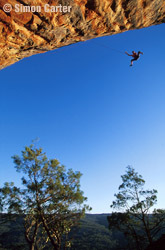
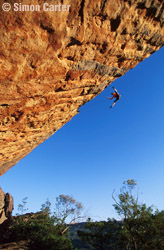

Above: Julian Saunders, Shattering
Reflections of Narcissism (29), Millennium Caves, The Grampians, Victoria,
Australia.
Falling is one of those aspects of climbing that you wrestle with continually. There was, however, certainly a point when I got a whole lot more comfortable with it. When I bolted Millennium Caves with Simon Atkins we decided to space the bolts a good distance for a number of reasons. We ended up taking some quite big falls, mostly into space. Two things make falling less scary; A) the more you fall the more comfortable you become with it. Fear of falling is mostly irrational, so the more you do it the more that fear is dispelled. Similarly, if you donít fall for a while it becomes unfamiliar, so you get scared again. And B) your belayer. A dynamic belay is 657 times more comfortable. If every time you fall is like hitting a concrete floor and then being slammed into a wall, you will have a bad association! A Pavlovian response if you like. I am sure I donít need to detail the physical and mental cascade that follows. Get a good belayer and fall lots and suddenly it is not so bad. Equally, short falls are often paradoxically more scary, as you donít get time to relax in the air and they tend to be less dynamic.
Right now however I am in a scared
shittless phase. I havenít being falling much and my favourite belayer
lives in Sydney.
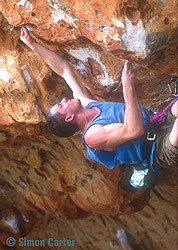
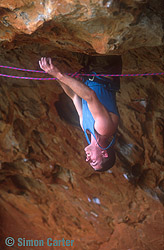
Above: Julian Saunders on Superdelux
(28), The Gallery, The Grampians, Victoria, Australia. Photos By Simon
Carter.
Q: You've put up some reportedly bold routes, for example "Daedelus" (28) on Taipan Wall, in the Grampians. I've been told someone once asked you why you generally space your bolts so far apart, to which you replied with the likes of "I'd rather climb than clip". That's a pretty cool quote. Were they your words? Is that still your sentiment today?
Yes, actually. Climbing is cool.
Getting lost in all the movement and struggle is an amazing experience; as
we all know. For me, clipping tars that experience a little, makes me feel
all human and vulnerable; it brings me back to earth if you like. It
reminds me of falling by virtue of the fact that it is the ramifications
of such that I am trying to protect myself against. It is a necessity yes,
but the less I have to do it the better. It is how myself and many others
like to climb, with bolts becoming further apart the higher you get, with
in reason. If you are not comfortable with falling you wonít like my
routes, or you will quickly get more comfortable.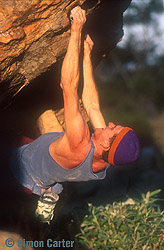
I donít like having a bolt at my waist all the time. I like the freedom of spaced bolts, I like that mental challenge of having to climb at you limit with the prospect of a long fall, of controlling your fears of falling, failure and whatever else it brings up for you.
Q: Bouldering seems to be high on your priorities. Do you prefer it over climbing routes? When you are leading do you prefer sport, trad, aid, ice? Do you free solo at all?
About 5-6 years ago I started bouldering when a few Austrians were out here. They were fantastically motivated and supportive irrespective of the grade you were climbing, which was great for me because I was significantly weaker than most of them (actually pissweak is probably more accurate). So I thought I would boulder some to get stronger so I could do a few projects I had. Well, I got a little distracted by it all and am still doing it; more for social reasons than preference of style. I must say that I am now perhaps turning a little corner. I have one project on Taipan that I would like to do, especially since I sent Nathan Hoette up there and he reported back that it is not as hard as I thought. Not that Nathan can be trusted with judging difficulty. Somebody put his butt cheeks where his shoulders used to be!
Above Right: Julian Saunders bouldering, Mount Arapiles, Victoria, Australia. Photo By Simon Carter.
Q: Rumour has it you
recently sent a ten meter, "high ball" line (at Andersons?), by working
the crux on a top rope, and then cruising up it as a "boulder problem". I
think most climbers would count ten meters as a route worthy of
protecting. Was it a scary solo? What was your motivation?
That has been one of the most
memorable things I have done. It is called Orca. I had a lot of trouble
down low and didnít really understand the movement. I tried it on tope
rope for a while. I was up there with Tim Fahey and a pad, just in case it
all came together. I did it clean for the first time that morning, and on
Chris Jonesí advice quickly pulled the rope, sussed the landing out just
in case, decided it was bad and I shouldnít fall, and then climbed it. Got
the shakes a bit at the top (I had skidded off pulling for the top on a
few occasions), but Tim wisely told me to relax. What a great spotter!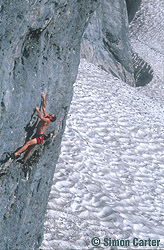
Dr Jones had a lot less trouble with it than I, though he kindly allowed me (and coached me through!) the first ascent. He was the first person I called after doing it.
Q: Most long time climbers have had their share of epics. It's hard to believe anyone who climbs as hard as you do, for as long as you have, hasn't had a near miss or two, if only from bad luck. Imagine the campfire is crackly warmly, your muscles have that well earned ache, and good friends are listening... what's your "there I was" story?
No epics as such, though I have made a stupid mistake or two; like forgetting to back up my bow line on Strolling at araps. I had just learnt how to tie one and it was way too good to have to back it up. Strolling was at my limit at the time. I had to put some gear in at the top, and as I pulled the rope up it practically came out of my harness. It was probably a little to early in my climbing career for it to really hit home, because uno, I would have bounced and been fine! I guess a year later I was trying that route Narcosis (aka Trail of Tears) and got distracted doing up my knot. I lent out, got my fingers in the first holds, and as I was about to throw my feet into the roof, Chris Wobblebuns (what an awesome surname) casually asked me if I thought I should finish tying in. Since then I tend to check about 900 times before I weight the rope in any circumstances.
Q: Your run your own
business "Athlon Sports Medicine", in Melbourne, having completed degrees
in Sports Physiology and Osteopathy. Firstly can you tell us a little
about the business? Is your main clientele comprised of climbers? What is
your range of services?
Climbers constitute probably 70% of my patients. 20% are performers of some nature e.g. Circus Oz and about 10% are what I would call the general population. Osteopathy is a form of musculoskeletal medicine. Really it is all about biomechanics; the goal is to keep your body working as a complete unit. When you get an injury it is often the end result a series of problems which culminate in something being damaged. Osteopathy is not just about looking directly at the injured site. It also focuses on getting those other factors in order so as to a) prevent the same thing happening again, and b) to Ďunloadí the actual injury so it can heal.
I think climbers come to see me
because 90% of the time I donít tell them they cannot climb, which for the
most part is futile anyway. Stevie Haston once told me ďnever tell
somebody to do something if they are going to disobey you; it undermines
your authority.Ē He was talking about his teenage daughter and her
boyfriend! Not only visionary parenting, but good all-round advice. Mostly
you can change the way you climb and avoid aggravating the injury.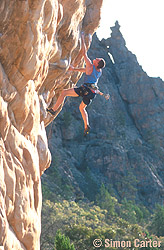
Although I treat most
musculoskeletal injuries, most of my patients come for an upper limb
injury initially, i.e. shoulder, elbow, wrist, fingers, and then they come
for their back, knee etc.
Q: Running your own business can be a demanding occupation. Are you able to balance work and climbing well? Does being your own boss have benefits when requesting time off for extended climbing trips?
I only have one rule; I will not work more than half the week. Three and a half days. Not more. The rest I spend climbing. Normally Saturday, Sunday, Monday, and Wednesday if I can manage it, which is about 50% of the time. Ross Taylor has Wednesdays days off so we often try for a day trip to the gramps. And of course the longer trips through the year. E.g. I was just in NZ for a few weeks.
Right: Julian Saunders, India (28), The Pharos, Mount Arapiles, Victoria, Australia. Photo By Simon Carter.
Q: When I spoke to you earlier in the year you were concentrating on light bouldering in an effort to recover from injuries. Presumably this put a dampener on ticking anything too hard last summer? Are you back to 100% again now? Were the injuries incurred while climbing?
I ruptured a ligament in my right
knee climbing in India, cartilage in my left knee on London Calling
(serves myself right for climbing at araps), ruptured a ligament in my
right elbow on Have a Good Flight (I am not a quick learner!) and
fractured a finger playing Frisbee (Xtreme Frisbee of course). The last 3
were all in 3 months. My left knee and my right elbow are still a bit
dodgy, but not really slowing me down. The 6 months between the first and
second injuries were fantastic. Did practically all my projects. And then
I got all brokenÖ
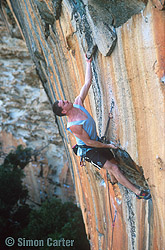
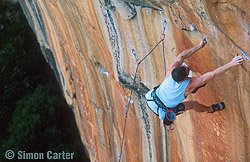
Above: Julian Saunders on his Chicane
(29), Taipan Wall, The Grampians, Victoria, Australia.
Q: Training for climbing. This should be a topic about which you've both experience and qualifications. Us mortals would dearly like to know how you got to be freeing such hard grades, and whether the secret lies in a replicate-able formulae; some kind of training and diet regime. Or is all just genetics? Do you spend a lot of time in the gym?
I like to balance the number of
hours I go climbing with the number of hours I spend eating. Thatís about
as technical as I get.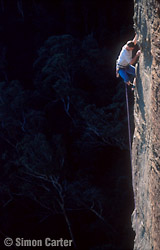
I am sure I would benefit from a more sophisticated program, but I like going climbing more than I like preparing for it.
Actually, I do have a secret recipe I use when I really need some power. I formulated and refined it some years ago. I guess now is the time I should share and let others benefit from it as well. Dosage is very important so experiment with how much you need to ingest for best results. Too much may have a rebound effect.
Right: Julian Saunders, Day of Reckoning (21), Narrowneck, Blue Mountains, NSW, Australia. Photo By Simon Carter.
Ingredients
400gr of dark chocolate, 10 eggs separated, 225gr of caster sugar, 4 table spoons of coco powder, 100gr of almond meal, and a buttered and floured 30cm sprung cake tin. You will also need to manufacture a disc that will fit into the aperture of the tin. Cover with tin foil and butter the bottom. Double card board works well.
Instructions
Melt chocolate and butter over
water and allow to cool slightly. Wisk in egg yolk. Add sugar, almond meal
and coco. Mix well. Beat egg whites until soft peaks are formed. Fold into
the formulae one third at a time, not any quicker, as the molecular
structure of the protein can be damaged. Pour into cake tin and place in a
180 degree preheated oven for 40min or until raised and slightly set. Take
from oven and place the disc on top of the cake. Place 2-3 bricks (or
something equally heavy) end on onto the disc. Allow to cool for one or
two hours.
This concoction combines lipids, sugars and protein in a ratio that will maximize your performance about 15-20 minutes after digestion. It can also be used as a recovery supplement, though to absorb all the nutritional goodies it is advised that you take a short nap immediately after consumption.
It is important to suffuse the various forms of saturated fats in order to reap their complete therapeutic benefits, so I recommend it be digested with king Island full cream. To make more palatable, a raspberry sauce can be added.
Boulderers, combine with a macchiato coffee for synergistic results. Warning, dexterity impairment and insomnia are common side effects.
Q: Have you climbed
overseas? Can you relate some of your experiences with climbing in other
parts of Australia and the world? Is there one particular trip that stands
out?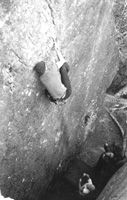
I recently went to NZ bouldering at a place called Flock Hill. Holly molly, it is HOT. Big proud lines, and very few of them done. Since I started working I realize that I can afford to rent a house (with a hot tub outside) and hire a car, and not live in a dank tent all the time and eat rice after my weakly budget has been spent. It is really very novel.
I have climbed a lot OS. Had some amazing experiences with great friends. Articulating them here, however, is way beyond the scope of my dyslexic typing ability let alone my literary skills.
Q: Okay, generic question time, what's your favourite crag in Victoria, and all time favourite climb?
Grampians. To difficult to say a single climb.
Q: Do you have a climbing hero/heroine?
No. Oh oh ohÖyes, Corinne. Sheís my Hottie.
Q: So what does your future hold in terms of climbing? Any big trips planned?
Excellent question.
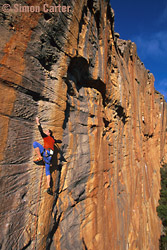
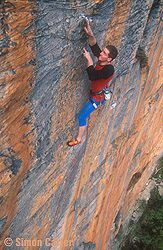
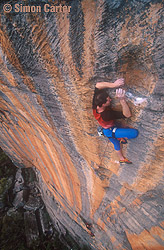
Above: Julian Saunders on Daedalus
(28), Taipan Wall, The Grampians, Victoria, Australia. Photos By Simon
Carter.
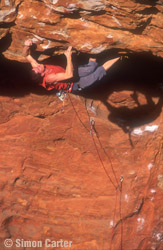
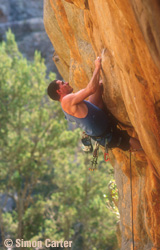
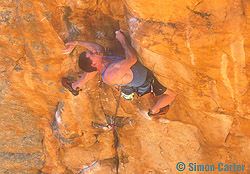
Above Left: Julian Saunders, Like a
Koala (30), The Gallery, The Grampians, Victoria, Australia. Above
Right: Julian Saunders, Slopin' Sleazin (28), The Pharos, Mount
Arapiles, Victoria, Australia. P
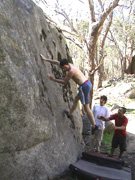
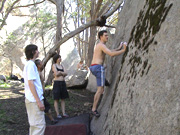
Above: Julian bouldering at the 2003
Chockstone Gathering, Dog Rocks, Mt Alexander.
 |
The FA of a new, high ball boulder problem at Dog Rocks, Mt Alexander is boldly ascended by Julian Saunders, despite moss, loose granite flakes, and no chalk bag. A nice dyno guards the opening moves, then it's sketchy pseudo-mantling on a mossy slab scoop before topping out gecko style. Audio included! (Video by Michael Boniwell). |
Further Reading:
![]()
Athlon Sports Medicine -
Osteopathy. Specialising in climbing injuries. 181 Brunswick St, Fitzroy.
Phone: 0400 201 551 or email
athlon@alphalink.com.au
Tape and Other Catastrophes
- Taping fingers to avoid further
injury? From Dr Julian Saunders.
Home | Guide | Gallery | Tech Tips | Articles | Reviews | Dictionary | Forum | Links | About | Search
Chockstone Photography | Landscape Photography Australia | Australian Landscape Photography
Please read the full disclaimer before using any information contained on these pages.
All text, images and video on this site are copyright. Unauthorised use is strictly prohibited.
